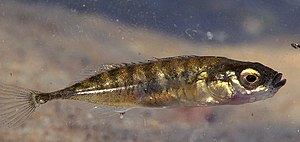Pungitius
| Pungitius | ||||||||||||
|---|---|---|---|---|---|---|---|---|---|---|---|---|

Nine-spined stickleback ( Pungitius pungitius ) |
||||||||||||
| Systematics | ||||||||||||
|
||||||||||||
| Scientific name | ||||||||||||
| Pungitius | ||||||||||||
| Coste , 1848 |
Pungitius is a genus of the stickleback family. Type species is the nine-spined stickleback and Europa terra typica . Thefish commonin the Holarctic are mostly freshwater inhabitants, but some populations also penetrate into brackish water and, more rarely, into salt water . They are extremely robust in the face of adverse environmental conditions and so a Pungitius species is often the sole colonist of small bodies of water or occurs there together with only a few other fish species.
features
The representatives of this genus have seven to twelve short dorsal spines which, with the exception of one species, are alternately left and right of the middle of the back. The pelvic fins each have a spiked and a soft ray. A shorter, curved spine stands at the beginning of the anal fin . The side signage formed from bone plates is not fully developed in all populations. The pelvic girdle is visible from the outside and consists of an abdominal shield with lateral extensions.
Systematics
|
Cladogram according to Takahashi et al. and Shikano et al.
|
As is not uncommon for sticklebacks, the genus includes a large number of more or less different populations. Their great variability makes, similar to Gasterosteus , a systematization difficult.
The following types can also be distinguished by DNA comparisons:
- Nine-spined stickleback ( Pungitius pungitius )
- Pungitius bussei
- Greek nine-spined stickleback ( Pungitius hellenicus )
- Pungitius kaibarae
- Pungitius laevis
- Southern nine-spined stickleback ( Pungitius platygaster )
- Pungitius polyakovi
- Pungitius sinensis
- Pungitius stenurus
- Sakhalin stickleback ( Pungitius tymensis )
- Pungitius vulgaris
supporting documents
- ↑ Hans-Joachim Paepke: The sticklebacks: Gasterosteidae , Westarp Wissenschaften, Magdeburg 1996, ISBN 3-89432-492-9 . P. 42
- ^ A b Petru M. Bănărescu, Hans-Joachim Paepke: The Freshwater Fishes of Europe , Aula-Verlag, Wiebelsheim 2002, ISBN 3-89104-658-8 . (Volume 5. Cyprinidae 2, Part III: Rhodeus to Capoeta; Gastorosteidae). P. 257
- ↑ Hiroshi Takahashi, Peter R. Møller, Sergei V. Shedko, Temirbekov Ramatulla, Sang-Rin Joen, Chun-Guang Zhang, Valentina G. Sideleva, Keisuke Takata, Harumi Sakai, Akira Gotoi, Mutsumi Nishida: Species phylogeny and diversification process of Northeast Asian Pungitius revealed by AFLP and mtDNA markers. Molecular Phylogenetics and Evolution, 2016, doi: 10.1016 / j.ympev.2016.03.022
- ↑ Wang, C., Shikano, T., Persat, H. & Merilä, J. (2015): Mitochondrial phylogeography and cryptic divergence in the stickleback genus Pungitius. Journal of Biogeography, Volume 42, Issue 12, pages 2334–2348, December 2015, DOI: 10.1111 / jbi.12591 * Yazdan Keivany & Joseph S. Nelson (2000): Taxonomic review of the genus Pungitius (Gasterosteidae). Cybium v. 24 (no. 2): 107-122.
- ↑ Yazdan Keivany, Joseph S. Nelson: Taxonomic review of the genus Pungitius, ninespine sticklebacks (Gasterosteidae) in Cybium, Revue Internationale d'Ichtyologie, Volume 24, No. 2, 2000. P. 107–122 ( Download English, PDF)
- ↑ a b Denys, GPJ, Persat, H., Dettai, A., Geiger, MF, Freyhof, J., Fesquet, J. & Keith, P. (2017): Genetic and morphological discrimination of three species of ninespined stickleback Pungitius spp. (Teleostei, Gasterosteidae) in France with the revalidation of Pungitius vulgaris (Mauduyt, 1848). Journal of Zoological Systematics and Evolutionary Research, Sep 21. 2017. DOI: 10.1111 / jzs.12178
literature
- Joseph S. Nelson : Fishes of the world , Fourth Edition, Wiley & Sons, Hoboken 2006, ISBN 978-0-471-25031-9 .
Web links
- Pungitius on Fishbase.org (English)